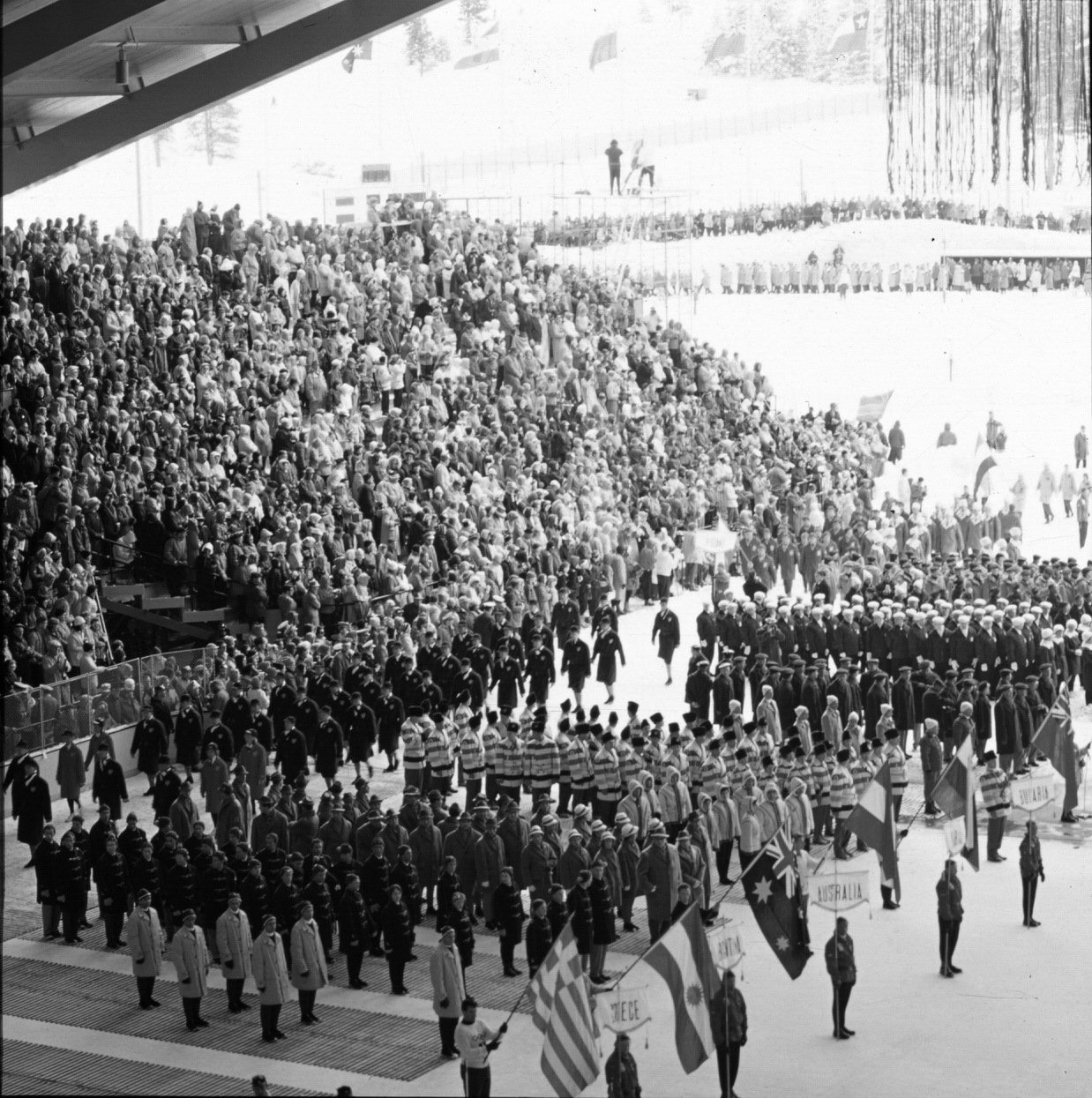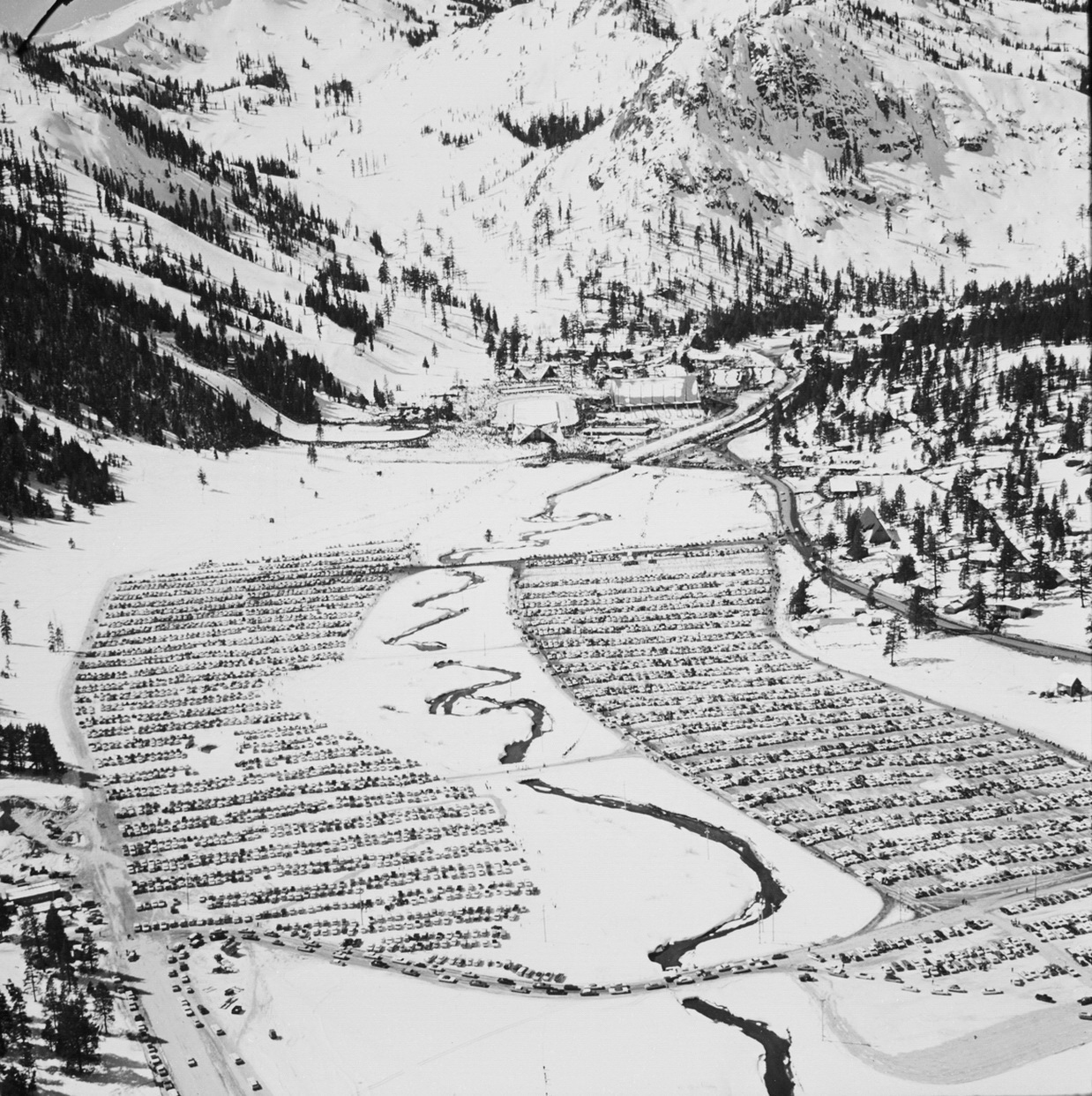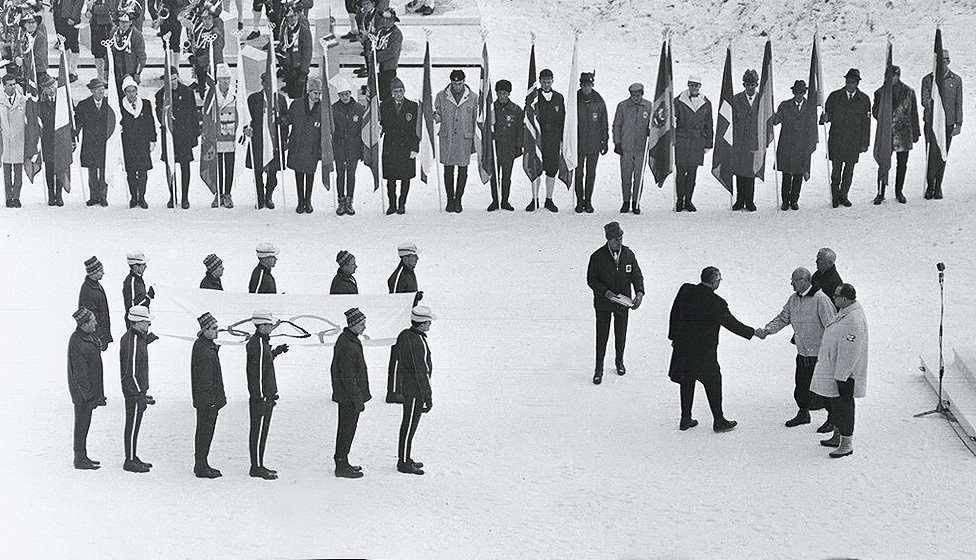Excerpt from Tales of Two Valleys by Eddy Starr Ancinas
The Opening Ceremony took place on 18 February 1960. A day that began with a blizzard and delayed the arrival of US Vice President Richard Nixon. No sooner did the delegations of the participating nations assemble ahead of the parade than the skies miraculously cleared, with the sun continuing to shine for the rest of the day. The Russians thought the US had the technology to control the weather.
01 – Aerial view of parking lots, photo by Bill Briner.
02 – Opening Ceremony, photo by Briner.
03 – Opening Day Ceremony, photo by Briner.
Wayne Poulsen looked with dismay at the parking lot on his land in the western end of the meadow. Months ago, when he learned that the planning committee was going to pave 130 acres for a parking lot, he convinced them that a better solution would be to compact the snow and mix in a layer of sawdust on top—a great idea, as long as the ground was frozen. Now, the day before thousands of cars would arrive for the opening ceremonies, the parking lot was thawing into 130 acres of mud.
On February 17, the night before the opening ceremonies, temperatures dropped, and the parking lot froze. Rain turned to snow and covered the racecourses, swirled in gusts through the valley and obliterated the road. U.S. Vice-president and Mrs. Nixon, unable to arrive by helicopter as planned, crept along with the masses in a stop-and-go slog of cars making their way into the valley to Blyth Arena, where they joined hundreds of hooded spectators groping their way through the blizzard to their seats in the ice arena.
At 1 pm, just one hour behind schedule, with the athletes lined up outside in the storm, a drum roll performed by hundreds of California and Nevada high school bands signaled the raising of the flags of Greece, the VIII Olympic Games, the American Flag and the Olympic Flag. Then, the flags of 31 nations reached the top of their standards, and as the Olympic Band played “The Parade of the Olympians,” the athletes followed their flag-bearers into the arena and stood in groups under the vast ceiling, as snow flew by outside.
While Prentis Hale, president of the Olympic Organizing Committee, made his welcoming speech, and Vice President Nixon declared the games open; all eyes looked up to Papoose Peak. The snow had stopped; the sky cleared, fireworks exploded, and thousands of balloons and pigeons (doves of peace) rose up into a blue sky. Andrea Meade Lawrence, 1952 double-gold medalist, skied down through the fresh powder carrying the Olympic torch and handed it to 500 meter speed skating champion, Kenneth Henry. After a lap around the outdoor rink, he climbed the steps to the urn at the Tower of Nations and lighted the Olympic cauldron for the 1960 winter games.
Athletes and spectators, to this day, ask themselves if legendary event-master, Walt Disney, included weather control as part of his Olympic opening spectacle.
California’s now notorious blind luck let the snow continue through the night, followed by a week of sunshine. During that now famous and much chronicled week, athletes enjoyed the first and only winter Olympics where they could walk or ski from race course to ski jumps to ice rinks and back to their own village. Only the cross-country and biathlon events were held outside of the valley. Spectators joined competitors on the mountains, along the rails of practice arenas and inside at Blyth Arena to cheer their comrades and teammates. By the end of the week, everyone was rooting for the plucky U.S. hockey team, when they defeated the mighty Russians, and then—with helpful advice from the Russian coach and the vocal support of his team—won the gold medal in a grand finale match with Czechoslovakia.
During the Games, I.O.C. members stayed at the Squaw Valley Inn (now Plump Jack’s), where fresh seafood and California produce, flown in daily from San Francisco, was elegantly prepared and accompanied by California’s finest wines. Walt Disney’s nightly shows in the athlete’s center united coaches and athletes from all nations, and (unbeknownst to officials) attracted a number of locals over the well-trodden trails through the forest behind the complex. With no lodging for the public in the valley, every bed, couch and available floor space was occupied in the 100 ski chalets located along the road into the valley. Newly opened motels in the nearby towns of Truckee and Tahoe City sold out at $25 per person a night.
Declared, “the best Winter Olympics ever” (an opinion still held by athletes, spectators and officials), Squaw Valley will long be remembered for its many “firsts”– the first time a woman (gold medal skater, Carol Heiss) took the Olympic oath, the first women to compete in speed skating, the first Olympic biathlon, the first time the games were televised on one network (CBS) with instant replay, the first time results and scores (including speed, distance and style) were electronically tabulated (IBM) and the first time metal skis were used—insuring that a nation (France) other than Austria dominated the men’s downhill.




